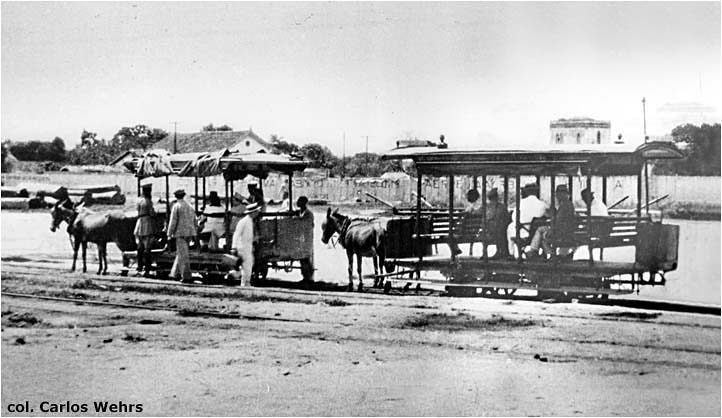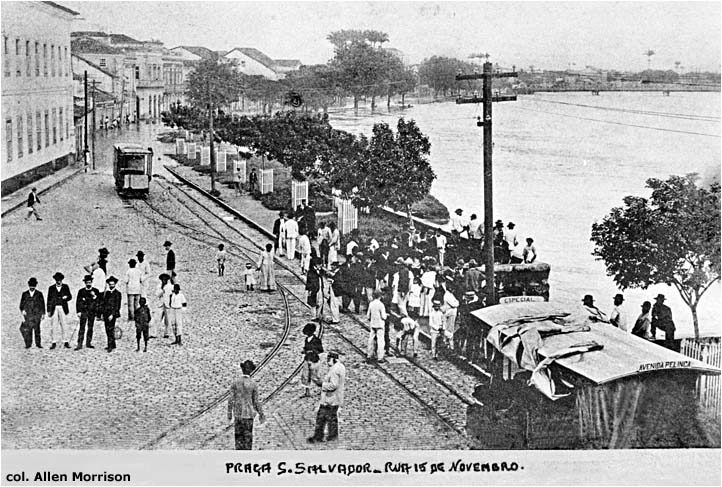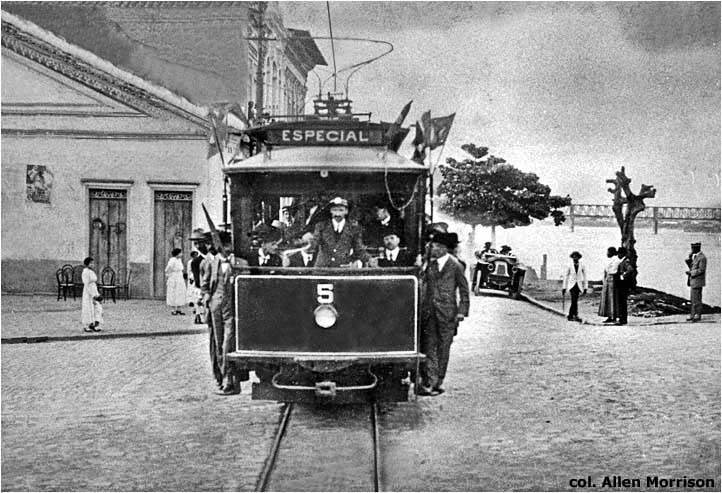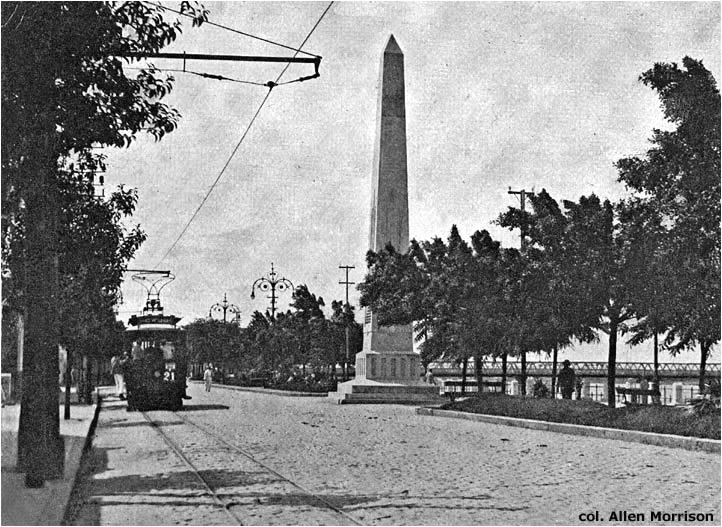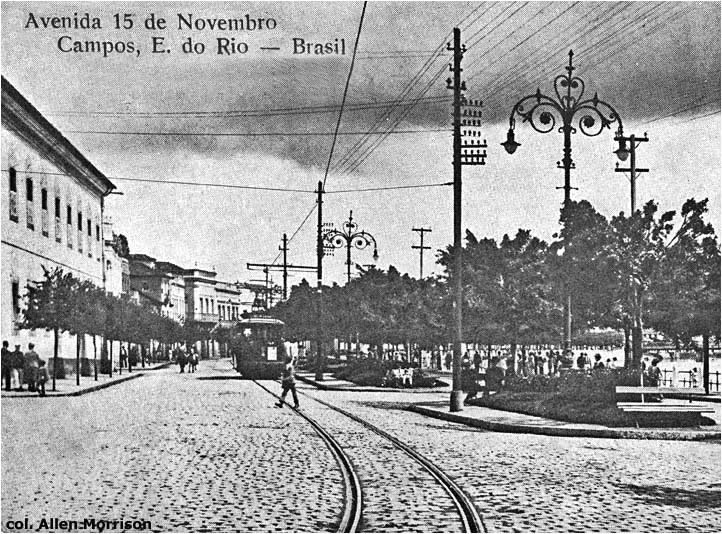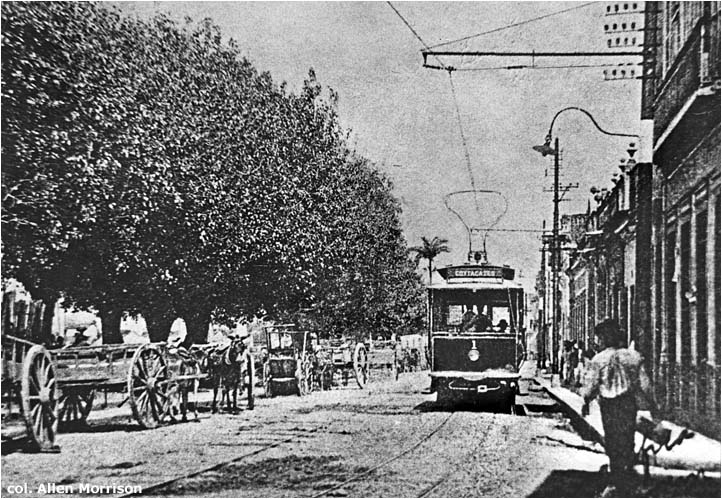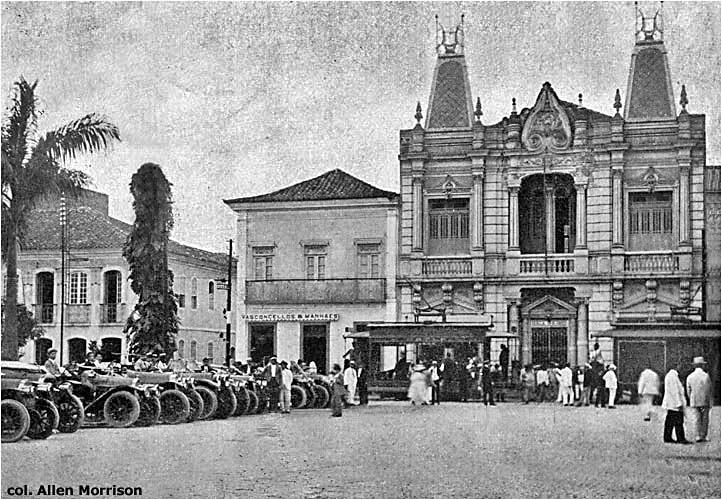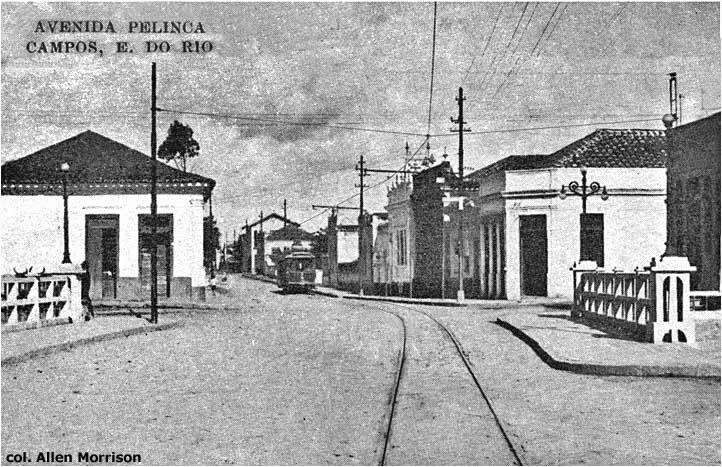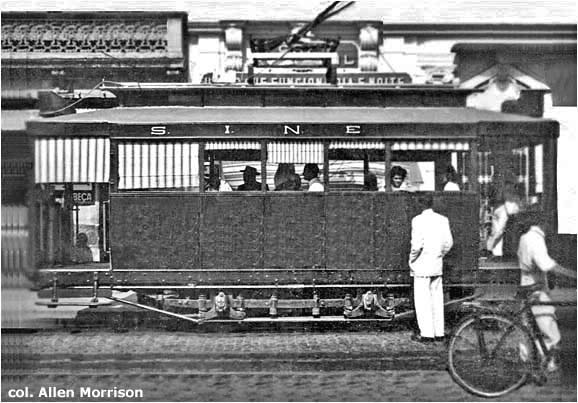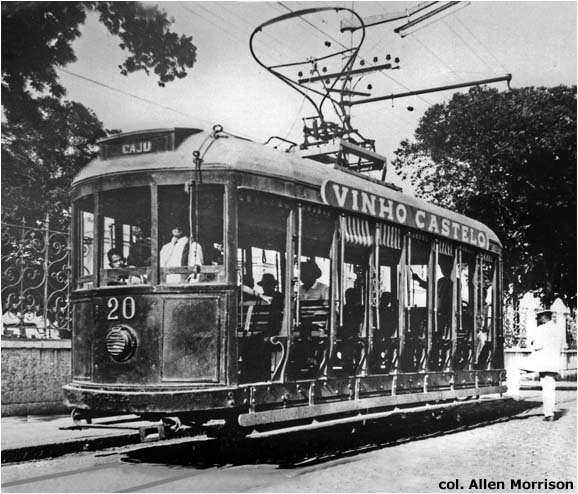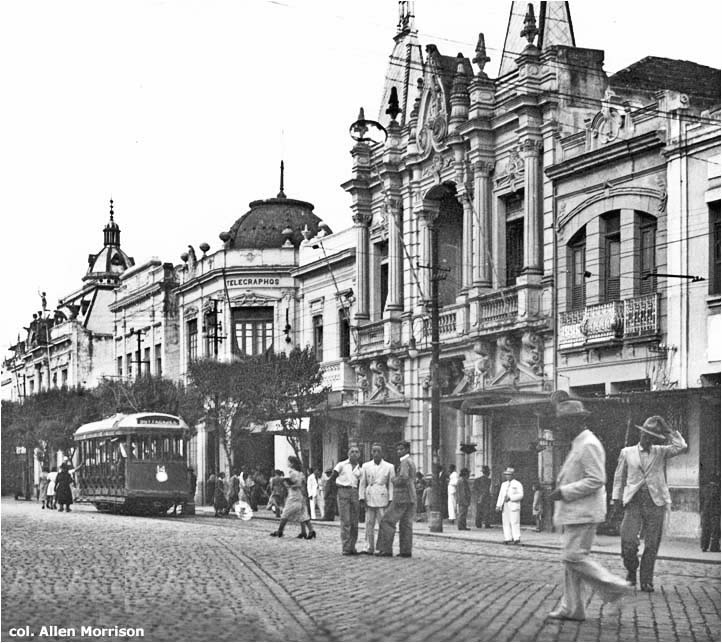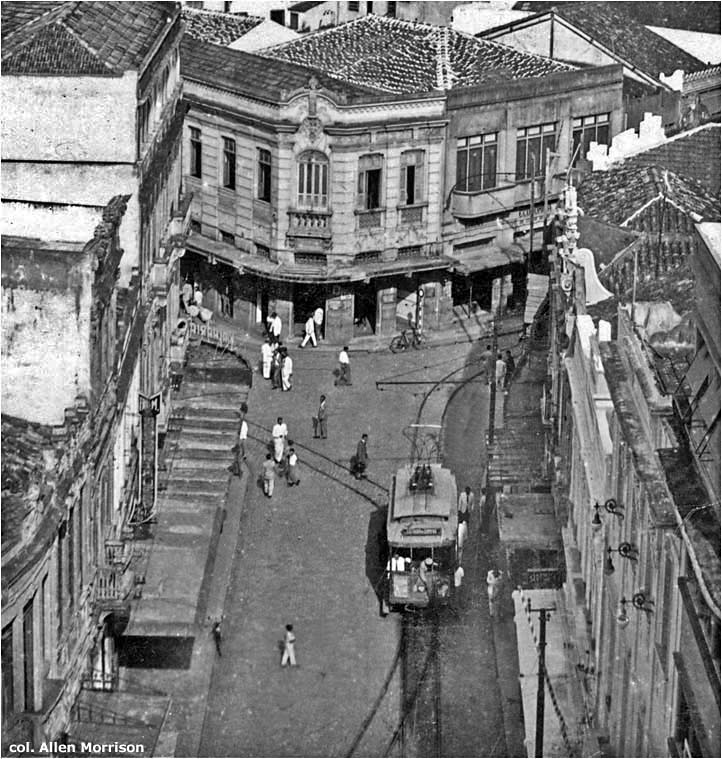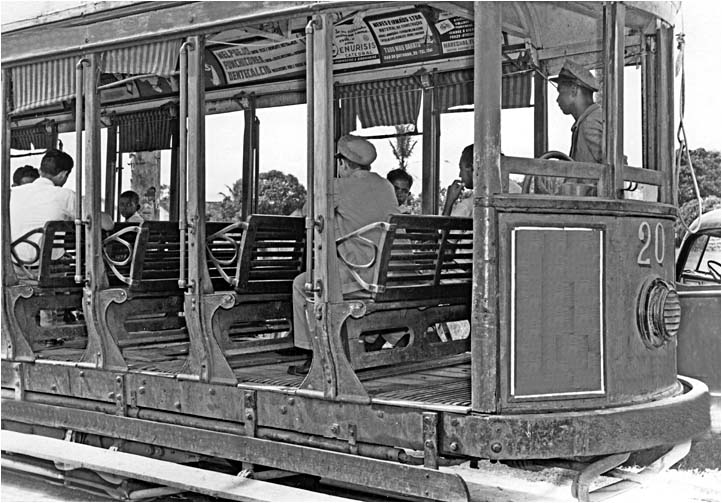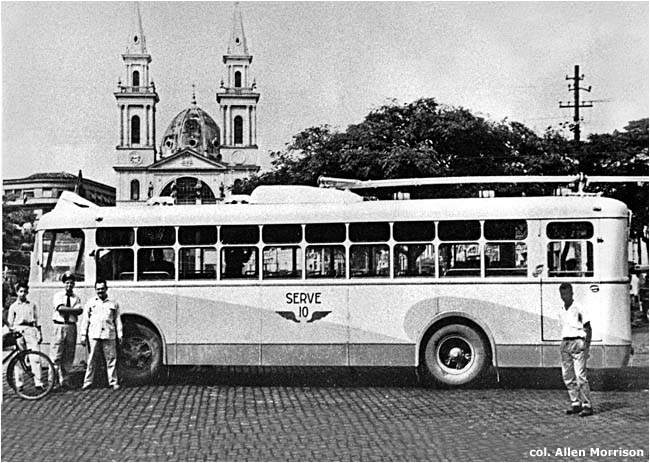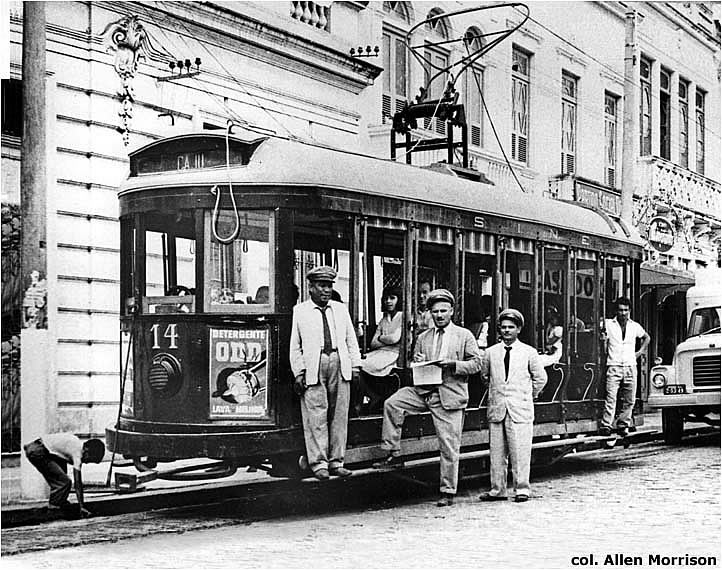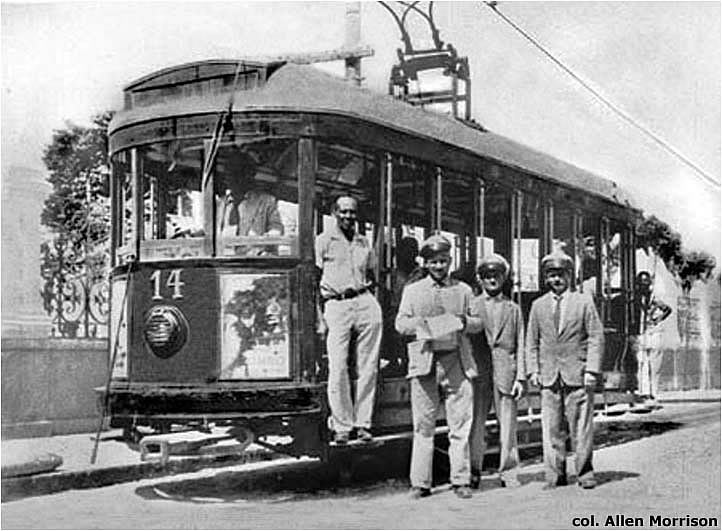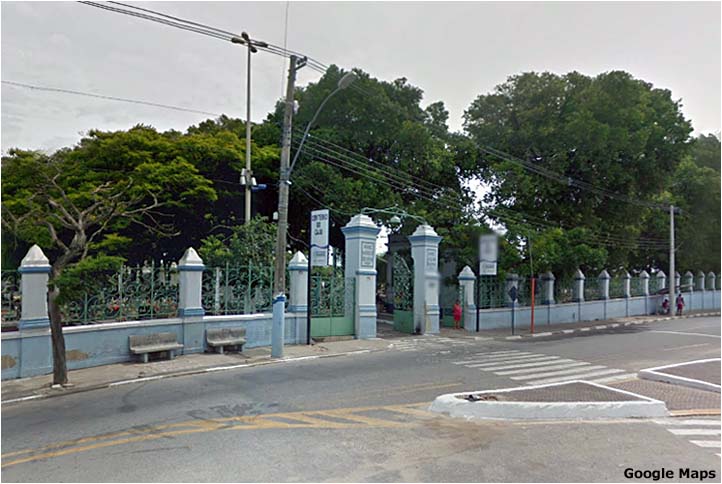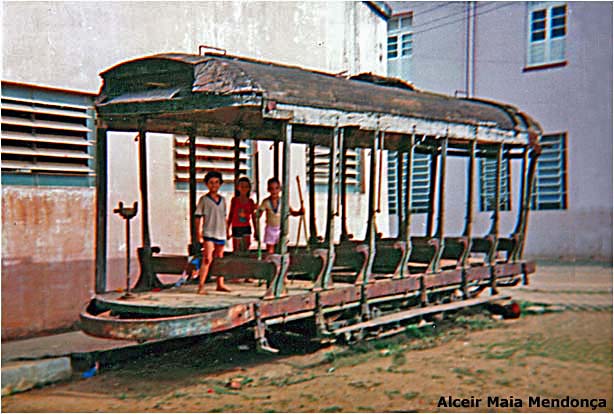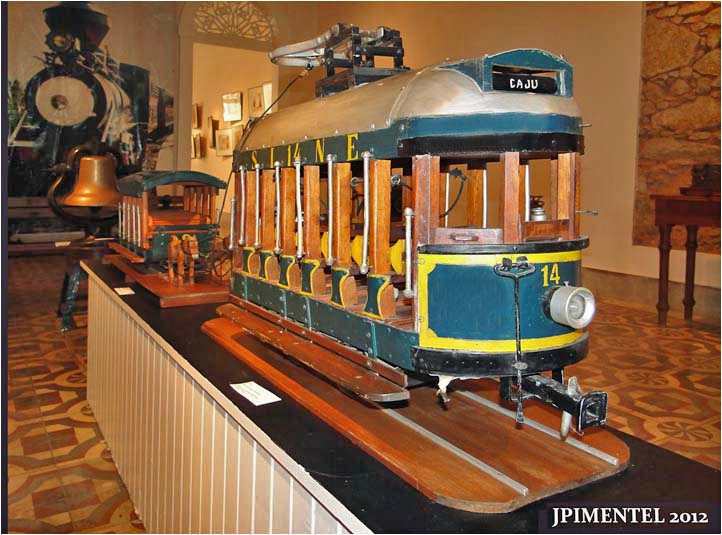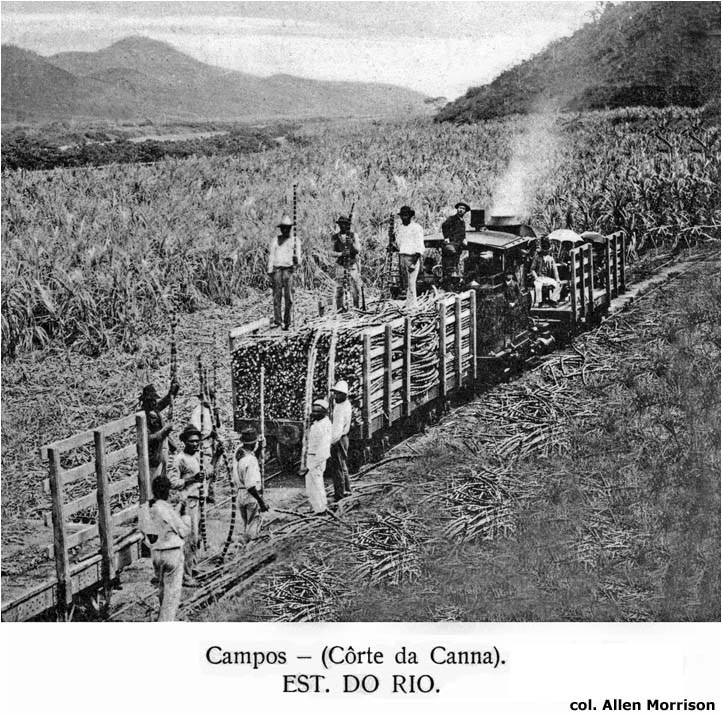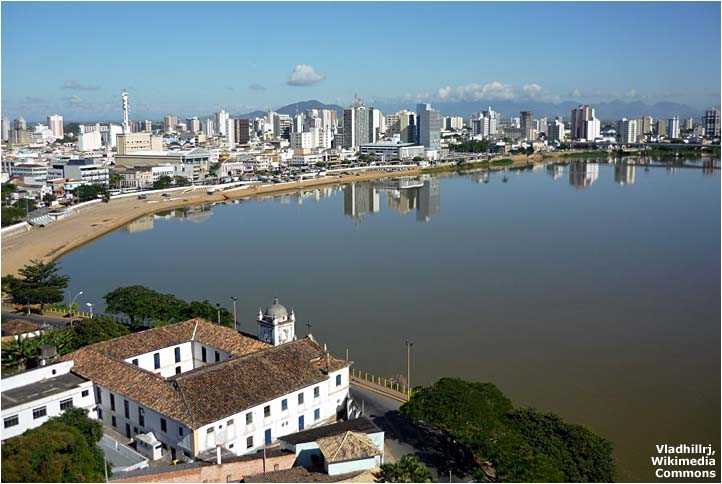The Trams & Trolleybuses of C A M P O S Rio de Janeiro state BRAZIL BY The steam railroad from Niterói and Macaé arrived in January 1875 [see area map] and the Ferro-Carril de Campos opened a horsedrawn tramway along Av. Alberto Torres, between the Estação de Saco and Praça São Salvador, the following 19 September [see city map]. The photograph below shows two of its tramcars [col. Carlos Wehrs]:
The horse tramway provided the city's only public transportation for the next 41 years. Proposals began in 1891 to build a line across the river; but nothing materialized. This postcard view shows tramcars on Av. 15 de Novembro blocked by one of the region's frequent floods [see map] [col. AM]:
The tramway spread through the city. According to Brazil's Anuário Estatístico [see BIBLIOGRAPHY, below], the Ferro-Carril de Campos operated 20 passenger cars and 5 freight cars on 16 km of track in 1912. It carried 1,982,000 passengers and had 71 employees and 181 mules. The Companhia Brasileira de Tramways, Luz e Força was registered in Campos on 13 August 1914, and between 1914 and 1916 ordered ten 6-bench electric tram cars from Trajano de Medeiros & Cia in Rio de Janeiro and ten model 21-E trucks from J. G. Brill Co. in Philadelphia (Brill orders 19806 and 20126). CBTLF tested its first electric tram on 28 September 1916, began revenue service on 14 October and – in the presence of Rio de Janeiro governor Nilo Peçanha and Brazilian president Wenceslao Braz – formally inaugurated the city's electric tramway system on 5 November 1916. Track gauge was one meter [col. Biblioteca Municipal Nilo Peçanha]:
The postcard view below shows one of the new electric trams passing the obelisk on Av. 15 de Novembro [see map]. The obelisk is still there today. The postcard was mailed in 1925 [col. AM]:
Another postcard view of a tram running along the riverfront park on Rua 15 de Novembro [see map] [col. AM]:
Tram 1 at an unidentified location on the Goytacazes line [see map] [col. AM]:
Two electric trams on the east side of Praça São Salvador [see map]. The tram on the right seems to be a freight model. The ornate theater belongs to the Sociedade Musical Lira de Apolo. The automobiles and clothing suggest 1920, but the postcard was mailed in 1928 [col. AM]:
This tram is headed toward Av. Pelinca, behind the photographer [see map]. The view is east. The bridge crosses the Campos-Macaé Canal [postcard, col. AM]:
Ownership and operation of the tramway passed to the Prefeitura Municipal in 1923 and to the Serviços de Força, Luz e Viação in 1928. The World Survey of Foreign Railways [see BIBLIOGRAPHY] reported 10 motorized passenger cars, 11 passenger trail cars and 2 motorized freight cars running on 22 km of track in Campos in 1933. The tram – and later trolleybus – depot was on Rua Tenente Coronel Cardoso [see map]. Operation was transferred in 1934 to the Serviços Industriais do Estado, which was reorganized in 1940 as Serviços Industriais do Norte do Estado ("SINE"). The latter enclosed one of its original 6-bench open cars, which it nicknamed "Bonitão". It kept its original Brill 21-E truck [col. AM]:
[See photos of Brill 21-E truck.] In 1942 SINE acquired ten 8-window closed cars from the tramway system in Petrópolis, which had discontinued rail service in 1939 [see area map]. It is believed that the trams shown in the remaining photographs on this page were reconstructions – either by SINE or by Trajano de Medeiros in Rio de Janeiro – of these secondhand cars from Petrópolis [col. Wanderley Duck]:
The IBGE survey of 1945 [see BIBLIOGRAPHY] reported 16 motorized passenger cars, 2 motorized freight cars and 2 freight trailers on 20 km of track. The tramway had 140 employees and carried 8,143,000 passengers that year. The following postcard shows rebuilt car number 14 on Praça São Salvador in the 1940s [see map]. Note the old theater, also seen in an earlier view. The theater is still there today – although the domed TELEGRAPHOS building next to it is gone [col. AM]:
Looking south down Rua 13 de Maio toward its junction with Rua 7 de Setembro [see map]. These are pedestrian-only streets today [postcard, col. AM]:
Campos also acquired a few trams second-hand from the Niterói system in the late 1940s. The postcard below, dated November 1947, shows an unidentified tram passing the swimming pool of the Clube de Regatas Saldanha da Gama, near Praça São Salvador [see map]. There is a shopping mall in this spot today [col. AM]:
A happy scene on tram 20. Note trolleybus wires [col. Biblioteca Municipal Nilo Peçanha]: An unusual interior view [col. Biblioteca Municipal Nilo Peçanha]:
In May 1951 Campos received an offer of second-hand trams from the Cincinnati Street Railway in the USA, which had closed its system in April. The offer was puzzling for the cars were clearly unsuitable: 4-axle models 14 meters long, bogies built for 1587 mm gauge track (Campos used 1000), controls at only one end (Campos would have to build loops to turn the cars around), etc. SINE did not want to reconstruct its system so rejected the offer. Besides, there was another new development that year... A SINE engineer named Ariosto de Lannes Rabelo had planned a trolleybus system in Campos in 1937 – a dozen years before Brazil's first system opened in São Paulo. His dream finally came true in 1951, when the Rio de Janeiro state government purchased 45 model VBRh trolleybuses from Société Anonyme des Véhicules et Tracteurs Électriques [VETRA] in France for operation in Niterói, Campos and Petrópolis. The Campos Folha do Comércio of 21 March 1952 announced that its "bondes obsoletos" would soon be replaced by 15 new trolleybuses imported from France. The 45 trolleybuses arrived in Niterói on 4 March 1953 and that city inaugurated its trolleybus system the following November. In 1954 SERVE, its transport operator, sent VETRA trolleybus number 10 to Campos for display [see Jornal Ururau]. The photograph below was taken on Praça São Salvador, in front of the cathedral, on 22 September 1954 [see map] [col. AM]:
Trolleybus 10 was exhibited at the city's Exposição Agropecuária the following week. SERVE sent eight more VETRA trolleybuses in 1957 and SINE inaugurated the first line of the Campos trolleybus system, from Praça São Salvador to the "Estação de Saco", on 29 June 1958 [see map and Folha do Comércio article of 1 July 1958]. Later that year the "Estação de Saco" ("Estação de Campos") line was extended around Rua Tenente Coronel Cardoso to form a loop. A new line went to Parque Leopoldina in 1959, alternate turns were constructed in the city center, and the long line to Usina Santo Antônio opened in 1962. The Campos trolleybus system expanded, but the fleet remained small: it seems that SINE never acquired the 15 trolleybuses originally planned. Petrópolis ordered wiring for a trolleybus system in 1956, but changed its mind and never operated a trolleybus system. The VETRA trolleybuses in Campos and Niterói, along with those in Santiago de Chile, were the only French-made trolleybuses in the Americas. Meanwhile, the city's trams kept running – at least numbers 14 and 20, which seem to be the only ones shown in photographs of the era. But their days were numbered. The vehicles and the rails they used were a half-century old and buses already served their routes. Power failures and floods encouraged bus operation. Tram 14 made the final trip on the Caju line on 14 November 1964, the 75th anniversary of the Brazilian republic. The photograph below shows the car as it prepared to leave Praça São Salvador for the last time [see map]. The motorman was Alex Marmelo, the inspector with the tablet was Vicente Paulo Calheiros, and the conductor was Bento Benício Ribeiro Moço [col. Biblioteca Municipal Nilo Peçanha]:
Here it is at the cemetery, right before it returned to the tramway garage forever [see map] [col. Biblioteca Municipal Nilo Peçanha]:
This 2013 view shows that same spot at the cemetery gate where tram 14 had bid farewell 49 years before [Google Maps 'Street View']:
The Campos tramway system had run for 89 years, 48 of them electrically. The trolleybus system closed three years later, on 12 June 1967. It had run less than nine years. The suburban line to Santo Antônio sugar mill was the last. The VETRA trolleybuses were allegedly sold for scrap to a steel mill at Volta Redonda [see area map]. Tramcar 14 was "saved" and placed on display in October 1977 at the Oswaldo Lima Civic Center, where the photograph below was taken [Alceir Maia Mendonça]:
In 1987 several prominent city leaders formed the "Comissão Bonde 14" to restore the car and preserve it in a museum. But it seems that it was scrapped. Only this model by local artist Alceir Maia Mendonça was preserved in a museum [J. Pimentel]:
Rio de Janeiro state was noted for its sugar plantations, which often had private steam-powered railways. This postcard view shows an unidentified line near Campos [col. AM]:
The city today. View is southwest across the bend in the river [see map] ['Vladhillrj', Wikimedia Commons]:
BIBLIOGRAPHY U.S. Bureau of Foreign & Domestic Commerce. World Survey of Foreign Railways. Washington, 1933. Tramway data for Brazilian cities, including Campos. Instituto Brasileiro de Geografia e Estatística. Conselho Nacional de Estatística. Transportation - Meios de Transportes - Transportiloj, 1945. Rio de Janeiro, 1945. Trilingual data for Brazil's principal tramway systems in vol. II, p. 93ff. "Campos contará, dentro de um ano, com o que há de mais moderno em transporte coletivo" in Folha do Comércio (Campos), 21 III 1952. Excellent early article about the city's trolleybus project. See handwritten transcription. "Inaugurada com a presença do governador Miguel Couto a primeira linha de ônibus elétricos" in Folha do Comércio (Campos), 1 VII 1958. Description of trolleybus inauguration, with four trolleybuses, two days before. The article emphasizes the contribution of Engineer Lannes Rabelo and says that the "Cia. Vetre" will ship 50 more trolleybuses soon... See handwritten transcription of the article. Guia Geral da Cidade de Campos - 1963. The chapter "Bondes à tração animal, elétricos e trolleybus: sinópse histórica" on pp. 8 and 13 outlines transport development. But data end in 1961. Three beautiful color drawings by Sylvio Prestes of SERVE trolleybus number 10. Good description. "Há 55 anos, era inaugurada a 1ª linha de ônibus elétricos em Campos" in Jornal Ururau (Campos), 29/6/2013. Excellent chronology of trolleybus history. Link.
The author is looking for pictures of trolleybuses in service in Campos...
See my index of If you have comments, criticism, suggestions This site was placed online on Copyright © 2013-2113 Allen Morrison |
